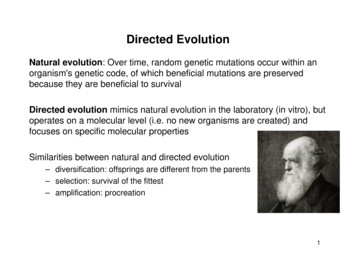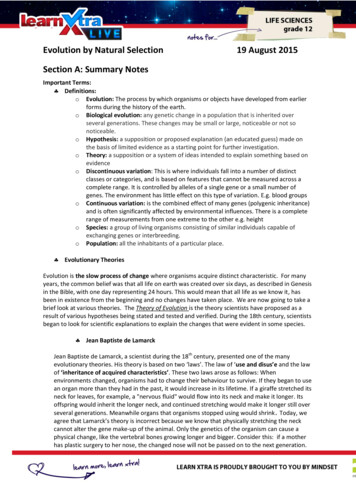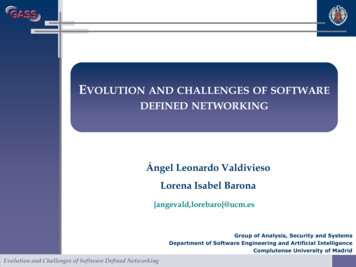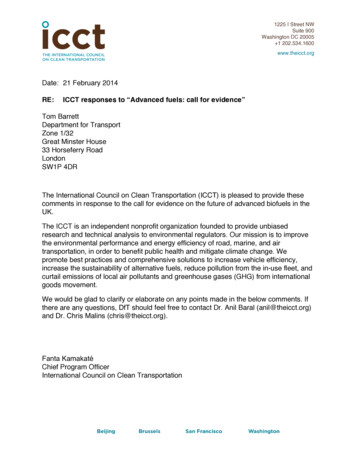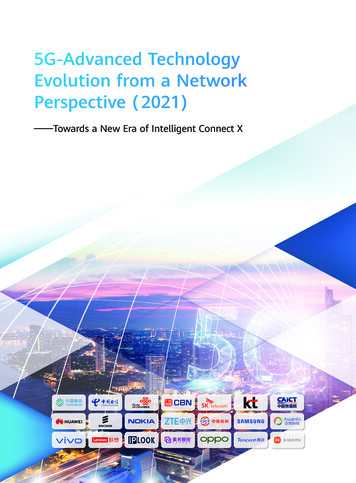
Transcription
5G-Advanced TechnologyEvolution from a NetworkPerspective ( 2021)——Towards a New Era of Intelligent Connect X
AbstractThe commercialization of 5G networks is accelerating globally. Fromthe perspective of industry development drivers, 5G communicationsare considered the key to personal consumption experience upgradesand digital industrial transformation. Major economies around theworld require 5G to be an essential part of long-term industrialdevelopment. 5G will enter thousands of industries in terms ofbusiness, and technically, 5G needs to integrate DOICT and othertechnologies further. Therefore, this white paper proposes thatcontinuous research on the follow-up evolution of 5G networks—5G-Advanced [1] is required, and full consideration of architectureevolution and function enhancement is needed.This white paper first analyzes the network evolution architectureof 5G-Advanced and expounds on the technical developmentdirection of 5G-Advanced from the three characteristics of ArtificialIntelligence, Convergence, and Enablement. Artificial Intelligencerepresents network AI, including full use of machine learning, digitaltwins, recognition and intention network, which can enhance thecapabilities of network's intelligent operation and maintenance.Convergence includes 5G and industry network convergence, homenetwork convergence and space-air-ground network convergence, inorder to realize the integration development. Enablement provides forthe enhancement of 5G interactive communication and deterministiccommunication capabilities. It enhances existing technologiessuch as network slicing and positioning to better help the digitaltransformation of the industry.Source CompaniesChina Mobile,China Telecom, China Unicom, China BroadcastingNetwork, SK Telecom, KT, CAICTHuawei, Ericsson (China), Nokia Shanghai Bell, ZTE, CICT, Samsung,AsiaInfo, vivo, Lenovo, IPLOOK, UNISOC, OPPO, Tencent, Xiaomi(The list above is not in any particular order)
Contents1 5G Development . 011.1 Progress .011.2 Driving Forces .011.2.1 Industries Requirement .011.2.2 Network Technology Evolution.032 5G-Advanced Architecture and Technical Trends . 043 Key 5G-Advanced Technologies . 063.1 AI for Network .063.1.1 Key Technologies of AI for Network .063.1.3 Application .073.2 Industry-Specific Networks .083.3 Home Networks.093.4 Space-Air-Ground Networks .093.5 Interactive Communications .103.6 Deterministic Communications .113.7 User Plane Customization.123.8 Network Slicing .123.9 Positioning, Ranging and Perception Enhancement .133.10 Multicast and Broadcast Services .133.11 Policy Control Enhancement .134 Conclusion . 14
015G Development1.1 ProgressThe global commercial deployment of 5G networks is in fullswing. As of April 2021, 162 5G networks in 68 countries andregions have been commercially released [2]. On top of this, overa thousand industry-specific applications have been projectedto benefit from the advantages offered by 5G, such as highbandwidth, low latency, and strong connectivity. In terms ofconnectivity specifically, GSMA predicts that 5G will boost themassive number of connections from 200 million in 2020 to 1.8billion in 2025[3].Overall, the global 5G industry is still in the early stages ofnetwork construction. The industry generally believes that "thefuture 6G technology" will not be applied until 2030. Therefore,whether in terms of business scenarios, network technology,industrial progress, deployment pace, etc., the next 3 to 5 yearswill still be critical for 5G development.For this reason, 3GPP initially determined 5G-Advanced as theconcept of 5G network evolution at the PCG #46[1] meetingheld in April. In the future, all aspects of the telecommunicationsindustry will gradually improve the framework and enrich thecontent for 5G-Advanced starting from R18.In the process of end-to-end 5G-Advanced network evolution,the evolution of the core network plays a pivotal role. On theone hand, the core network is connected to various services andapplications, which is the convergence point of the entire networkbusiness and the engine of future business development. On theother hand, the core network is connected to various standardterminals and access networks, the whole network topology.The center moves the entire body. Therefore, promoting 5G corenetwork technology and architecture evolution based on actualbusiness needs will help operators improve return on investmentand help industry users better use 5G networks to achieve digitaltransformation.1.2 Driving Forces1.2.1 Industries RequirementUnlike previous generations of communication networks,5G is considered the cornerstone of the industry's digitaltransformation. The world's major economies have requested5G as an essential part of long-term industrial development.For example, the European Union proposed the 2030 DigitalCompass (Digital Compass) plan, which formulated outlinesfor commercial digital transformation and public servicedigitalization. It adopted 5G as the basis for Industry 4.0. As thefirst country to deploy 5G, South Korea has further strengthened015G-Advanced Technology Evolution from a Network Perspectivethe construction of a 5G converged ecosystem and promoted5G united services. Japan continues to promote the value of B5G(Beyond 5G) to people's livelihood and society. China has also putforward a long-term goal for 2035 driven by insisting on scientificand technological innovation and deepening the "5G IndustrialInternet" as its important current goal.
Therefore, 5G-Advanced needs to fully consider the evolutionof the architecture and enhance functions, from the currentconsumer-centric mobile broadband (MBB) network to the coreof the real industrial Internet. However, it is currently possibleto use network slicing, MEC (Multi-access Edge Computing),and NPN (Non-Public Network) to serve the industry. Whetherit is network deployment status, business SLA (Service LevelAgreement) guarantee capabilities, easy operation andmaintenance capabilities, and some auxiliary functions neededby the industry, the current capabilities of the 5G network arestill insufficient. Thus it needs continued to be enhancements in3GPP R18 and subsequent versions.First of all, in the future, XR (Extended Reality) will becomethe main body of business carried by the network. Not only willthe definition of XR be upgraded from 8K to 16K/32K or evenhigher, AR (Augmented Reality) business scenarios for industryapplications will also evolve from single-terminal communicationto multi-XR collaborative interaction and it will develop rapidlybeyond 2025. Due to the impact of business traffic and businesscharacteristics, XR services will put forward higher requirementsfor SLA guarantees such as network capacity, delay, andbandwidth. At the same time, essential communication servicesstill have a lot of room for development. Multi-party video callsand virtual meetings represented by telecommuting will becomethe norm. The current conference mode of fixed access and videoand call will transform into a multi-party remote collaborationof mobile access and rich media and real-time interaction inbusiness. For example, corporate employees can access thecorporate office environment with virtual images at any time athome and communicate with them. Colleagues communicateefficiently. Therefore, 5G-Advanced needs to provide an upgradednetwork architecture and enhanced interactive communicationcapabilities to meet the business development needs of theexisting clear voice-based communication methods evolving tofull-aware, interactive, and immersive communication methods.It should also enable consumer experience upgrade.Second, industry digitization has brought about a much morecomplex business environment than consumer networks.Businesses in different industries, such as the Industrial Internet,Energy Internet, Mines, Ports, and Medical Health, needthe network to provide them with a differentiated businessexperience and provide deterministic SLA guarantees forbusiness results. For example, the Industrial Internet requiresdeterministic communication transmission delays that arebounded up and down, and intelligent grids need high-precisionclock synchronization, high isolation, and high security. Minesneed to provide precise positioning under the surface, ports needremote gantry crane control and medical health needs realtime diagnosis and treatment information, synchronization andsupport of remote diagnosis with ultra-low latency. Therefore,5G-Advanced needs to fully consider the deterministic experienceguarantee for industry services, including real-time serviceperception, measurement, scheduling, and finally forming anoverall closed control loop. For different industries, 5G needs toadopt public networks, local private networks, and various hybridnetworking modes to meet the industry's business isolation anddata security requirements. Therefore, 5G-Advanced should focuson the network architecture, networking scheme, equipmentform, and service support capability that matches the diverse andcomplex business environment.5G-Advanced Technology Evolution from a Network Perspective02
1.2.2 Network Technology EvolutionThe 5G-Advanced evolution is technologically presented as acomprehensive integration of ICT technology, industrial fieldnetwork technology, and data technology.The communication network after 4G fully introduces ITtechnology, and the telecom cloud is generally used as theinfrastructure. In the actual telecom cloud landing process,technologies such as NFV (Network Functions Virtualization),containers, SDN (Software Defined Network), and API(Application Programming Interface)-based system capabilityexposure have all received actual commercial verification.On the other hand, the network edge is the center of futurebusiness development. Still, its business model, deploymentmodel, operation and maintenance model, especially resourceavailability and resource efficiency, are pretty different fromthe centralized deployment of cloud computing. The LinuxFoundation proposed that after introducing the concept ofCloud Native to the edge, it also needs to combine the variousfeatures of the border to form an edge native (Edge Native)application form [4]. Therefore, the evolution of 5G-Advancedneeds to integrate the characteristics of cloud-native and edgenative, achieve a balance between the two through the samenetwork architecture, and finally move towards the long-termevolution direction of and cloud-network integration.For CT technology itself, 5G-Advanced needs to exert its networkconvergence capabilities further. These integrations include theintegration of different generations and different models of NSA/SA, as well as the integration of individual consumers, familyaccess, and industry networks. In addition, with the evolution ofsatellite communications, the 5G-Advanced core network willalso prepare for a fully converged network architecture orientedto the integration of ground, sea, air, and space.In addition to ICT technology, there will be more demandfrom production and operation in the future, and OT(Operational Technology) will bring new genes to mobilenetworks. For example, the Industrial Internet for industrial035G-Advanced Technology Evolution from a Network Perspectivemanufacturing is different from the traditional consumerInternet. It has more stringent requirements for networkquality. It is necessary to consider the introduction of 5Gwhile supporting minimal networking. Quality inspectionscenarios based on machine vision require the network tokeep both large bandwidth and low latency capabilities.Remote mechanical control requires the network to supportdeterministic transmission, guarantees the number ofconnections and bandwidth that can be promised, and theintelligent production line for flexible manufacturing alsoneeds to be provided by the precise network positioning, datacollection, and other capabilities. For this reason, wirelessaccess networks need to have the reliability, availability,determinism, and real-time performance comparable towired access. The integration of OT and CT will become animportant direction for the development of mobile networks.5G-Advanced networks will become the critical infrastructurefor the comprehensive interconnection of people, machines,materials, methods, and the environment in an industrialenvironment, realizing industrial design, R&D, production, andmanagement. The ubiquitous interconnection of all industries,such as services, etc., is an important driving force for thedigital transformation of the industry.In addition, DT (Data Technology) technology will also injectnew impetus into network evolution. The developmentfoundation of the digital economy is a massive connection,digital extraction, data modeling, and analysis andjudgment. Combining 5G network with big data, AI (ArtificialIntelligence), and other technologies can achieve moreaccurate digital extraction and build data models based onrich algorithms and business features. It can also make themost appropriate analysis and judgments based on digitaltwin technology and give full play to the digital impact whichwill further promote the evolution of the network.In summary, the full integration of DOICT will jointly drivenetwork changes and capacity upgrades and help the digitaldevelopment of the entire society in all fields.
02To meet the needs of personal consumer experience upgradesand digital transformation of the industry. 5G-Advancednetworks need to continue to evolve from the architecturaland technical levels to meet diversified business demands andenhance network capabilities.At the architectural level, the 5G-Advanced network needsto fully consider the concept of cloud-native, edge network,network as a service, and continue to enhance networkcapabilities and eventually move toward cloud-networkintegration and computing-network integration.-Cloud-native is a further cloud enhancement based onthe telecom cloud NFV to realize the flexible deploymentof 5G networks and the flexible development and testingof functions more quickly. Cloud-native needs optimizedsoftware to improve the utilization efficiency of hardwareresources, and a cloud-based security mechanism to achieveinternal security of the infrastructure.5G-AdvancedArchitecture andTechnical TrendsNF services.Operators use SBA as the network foundation, network slicingas the service framework, network platform as the core,and key network function APIs as the starting point to buildagile and customized 5G capabilities to help users deeplyparticipate in the definition and design of network services.Operators need an increasing number of network featuresaccessible via APIs so that together with slicing they canprovide possibilities for automated differentiated businessexperience and higher business efficiency for the users andmakes the connection and computing a powerful booster fordeveloping the 5G service industry.-Edge network is an efficient deployment form that combinesdistributed network architecture and edge services.-The Network-as-a-Service model makes 5G systems highlyflexible and can adapt to various customized solutions forvertical industry needs. The specific implementation form canbe 5G network slicing or independently deployed networks.The SBA service-oriented architecture design of the 5G corenetwork goes deep into the network logic, helping operatorsfully control the network and conform to the 5G networkdevelopment goal of "network as a service."This is because SBA is designed so that 5G network functions(NFs) could be developed stateless. It allows the NFs tobe modularized, flexible and more application-focused forefficient communication. One of SBA’s important role isto manage and control various communications betweenNF services efficiently, by using request/response andsubscription/notification based methods. SBA’s frameworkalso allows robust scaling, monitoring and load-balancing of5G-Advanced Technology Evolution from a Network Perspective04
IndividualsIndustriesAPINaaSrtificial IntelligenceAPICloud NativeManagement planeControl planeonvergenceUser planeUser planenablementData analyticsEdge NetworkUbiquitous accessFigure 2-1: 5G-Advanced network architectureBased on requirements that will be raised in the future,5G-Advanced networks need to have the characteristics of anACE: AI, convergence, and enablement. AIAs 5G develops, its applications and services are varyingamong industries. This leads to related network functions,management, and user behavior also becoming variableas well as complex. The network scale is continuouslygrowing, but the conventional network needs heavy manualconfiguration, which is labor-intensive and prone to errors.Therefore, high management overhead has been added. It isnecessary to introduce intelligent assistance to improve thecapabilities and quality of services at all levels, from networkfunctions to network management. ConvergenceThe convergence of different access modes and networksis the development trend of 5G-Advanced. Prior to the 5Gera, various industries built independent networks, which055G-Advanced Technology Evolution from a Network Perspectivewere used for long periods, and diverse terminals, accessmodes, and transmission approaches emerged. However, thenetworks' low versatility led to the long iteration time of newfunctions, high cost of equipment, and slow development oftechnology. Therefore, the next-generation network, whichshould connect the air and ground and accommodate the IIoT,Wi-Fi, fixed networks, and other multi-industry and multiprotocol services, has become essential. EnablementWith 5G being used in industries, network capabilitiescontinue to improve and gradually evolve from aninfrastructure to enable services. Introducing new capabilities,such as deterministic networking, customization, highreliability, global control and management, and self-evolutionto meet industry requirements, will facilitate the applicationof NaaS. This will enable 5G-Advanced to provide industrieswith customized networks featuring proactivity, flexibility, andresource isolation.
03Key 5G-AdvancedTechnologies3.1 AI for Network3.1.1 Key Technologies of AI for NetworkThe introduction of network resource virtualization, 5Gservice-oriented architecture, diversified services, and new5G capabilities such as slicing and edge computing havebrought challenges to 5G operations and commercial use.The application and integration of intelligent technology intelecommunication networks can improve network efficiency,reduce operation and maintenance costs, and improve thelevel of intelligent network operation.Starting from 3GPP Rel-16, to promote network intelligence,continuous advancement has been carried out on thetechnical standardization of network infrastructure (SA2)and network management (SA5). NWDAF is a standardnetwork element introduced by 3GPP SA2 in 5G. It is an AI big data engine. It has the characteristics of standardizationof capabilities, aggregation of network data, higher realtime performance, and support for closed-loop controllability.3GPP defines the location of NWDAF in the networkand the interaction and coordination with other networkfunctions and defines the flexibility of NWDAF deployment.NWDAF can be deployed in specific network functional unitsthrough function embedding and can also be coordinatedacross functional network units, to complete the closedloop operation of network intelligence. 3GPP SA5 definedManagement Data Analytics System (MDAS), which,combined with AI and machine learning, enables automationand cognition of the management and orchestration ofnetworks and services. The MDAS can mine data value innetwork management by processing and analyzing networkmanagement data. It can also generate analysis reports andprovide suggestions on network management and operationsto promote the intelligence and automation of closed-loopnetwork management and orchestration.The evolution of 5G networks has increased the networks'complexity and, in turn, their O&M. Networks are requiredto be highly intelligent, automated, and autonomous.The networks need to automatically adjust to meet therapidly changing service requirements according to changesin themselves and the environment. They also need toautomatically perform the required network updates andmanagement based on service and O&M requirements. Tofulfill these requirements, the following AI technologiescan provide reference for the intelligent development of5G-Advanced network.5G-Advanced Technology Evolution from a Network Perspective06
Machine learningAs a basic network intelligence technology, machine learningcan be widely used in various nodes and network controland management systems in 5G networks. Based on thelarge amount of subscriber and network data in the 5Gsystem, combined with professional knowledge in mobilecommunications, a flexible machine learning frameworkhas been adopted to build a network intelligent processingsystem that will be widely used and support distributed andcentralized deployment.with mobile communications expertise and fully utilizes thebig data analytics generated by the 5G network ,enhance theintelligence of network operations to enable complex anddiverse services. Intent-based networkIntent-based network technology enables operators to definetheir network goals, which the system can automaticallyconvert into real-time network operations. The network iscontinuously monitored and adjusted to ensure networkoperations remain consistent with the service intent. Digital twinDigital twin technology can improve the monitoring andcontrol of the network and prediction of its condition, forexample its status and traffic, simulate and evaluate thenecessary network changes in advance to help greatlyimprove digital network management.In the future, a company can introduce advanced frameworkssuch as federated learning to support the joint learningand training of multiple network functional units. This caneffectively enhance the training effect and protect dataprivacy. In addition, NWDAF can be deployed in layers, flexiblybuild a distributed intelligent network system, that respondsbetter to different needs. Cognitive networkCognitive network technology uses algorithms empoweredData RepositoriesData AccessNFNFDelivery of activitydata and localanalyticsNWDAFDelivery ofanalytics dataAFAFOAMFigure 2.2.2-1: General framework for 5G network automation[5]3.1.2 ApplicationTo realize the construction of intelligent network, empowerthe digital intelligence transformation of the industry, 5Gnetworks require the continuous introduction of AI Internally,it can better support connections, security, and management075G-Advanced Technology Evolution from a Network Perspectiveand utilize AI algorithms to transform cloud-based big dataresources into intelligent planning, analysis, fault diagnosis,and adaptive optimization capabilities.
AI can help 5G networks realize closed-loop optimizationof service experiences. First, user experience is intelligentlymonitored and then evaluated. Then, the optimal strategiesare recommended through intelligent comprehensive analysisbased on service requirements and network capabilities.Finally, policy adjustment and closed-loop tracking areimplemented through the service experience feedbackmechanism to balance network costs and service experience.For example, a relationship model between user experienceindicators and QoS indicators is built through intelligent dataanalysis and, based on this model, user experience of currentservices is monitored and evaluated in real time. In addition,differentiated QoS parameters that best match users, services,and networks are generated by analyzing and mining users'communication habits. Moreover, network slicing resourcesand services are intelligently scheduled and optimized throughreinforcement learning and other optimization algorithms toensure premium experience of services delivered by networkslices. What’s more, AI-based multi-access collaborationcan ensure that multi-access resource is fully utilized withimproving user experience.Externally, network intelligent technology makes full useof the computing power, data and scene advantages of thetelecom industry to redefine the end-tube cloud ecology andbuild a new business model of the telecom industry. Many5G applications require the cloud, the edge, and end devicesto work together to implement and orchestrate serviceswith the assistance of data collection, model training, andintelligent inference. To better use the available and everchanging computing and networking capabilities, AI needs tobe introduced to predict the computing and network loads,as well as optimally schedule the computing, storage, andnetwork resources across the cloud, the edge, and devices.Domain twin models can be used to simplify multi domainorchestration problems which would ensures that servicescan be practically and flexibly deployed and migrated onheterogeneous cloud-edge-device resources to provide therequired service quality with optimal resource utilization.3.2 Industry-Specific NetworksThe integration of 5G and industry networks will become akey scenario for 5G-Advanced networks for vertical industrycustomers. In the industry network, 5G network can bringmore business value, such as personnel protection, productionflexibility, and advantages in wireless and mobility. From theperspective of networking, it can not only greatly reduce thecomplexity and labor cost of wired networking but also helpindustry customers realize the ideal of "one network at theend." For example, in the field and workshop networking inthe industrial manufacturing field, 5G can simplify the multilevel wired network level at the vertical level to achievenetwork flattening. Based on the differentiated guarantee of5G deterministic capabilities, 5G can realize the IT networkof the field network ( Such as equipment operation andmaintenance data collection) and OT network (such as PLCcontrol) into one.The characteristic of the private industry network is toprovide third-party customers with a flexible and on-demandcustomized network within the scope of their operation andmanagement. The 5G industry private network can integratethe enterprise's network system with the 5G network to buildunified management and seamlessly integrated industrynetworks.1) Enhancement of network intercommunication5G-LAN technology can use 5G networks to replace local areanetworks in the current industrial field. Solve cable mobilitylimitations and high optical fiber laying costs in existingindustrial networks, and provide industry users with theability to quickly and flexibly build private mobile networks.5G-LAN defines a virtual network through the concept of agroup and supports point-to-point and point-to-multipointcommunication within the group. The 5G-LAN groupcan deploy one UPF or multiple UPFs and supports localexchanges within UPFs and intra-group communication acrossUPFs. The open API interface enables third parties to createor modify communication groups flexibly, thereby realizingdynamic group management. 5G Advance can enhance5G-LAN technology in the following aspects:-Further study the new requirements in industrial networks,enhance the layer 2 data transmission of mobile networksand expand the application scenarios of 5G-LAN in industrialnetworks. For example, factory complex scenarios requiregroup communications with service continuity amongnetworks, dynamic group communications in 5G LAN, and 5GLAN group QoS support.Convergent industry-specific networks have been enhanced inthe following three aspects:5G-Advanced Technology Evolution
concept of 5G network evolution at the PCG #46[1] meeting held in April. In the future, all aspects of the telecommunications industry will gradually improve the framework and enrich the content for 5G-Advanced starting from R18. In the process of end-to-end 5G-Advanced network evolution, the evolution of the core network plays a pivotal role .




